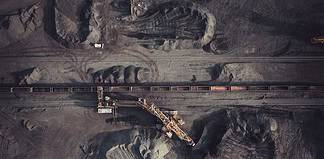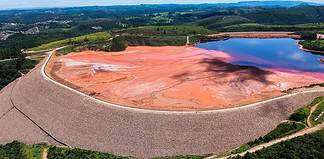Image: Rio Tinto.
BY ELIZABETH FABRI
AUSTRALIA’S only operational diamond mine – Argyle – is almost at the end of its run leaving a huge void for emerging juniors to fill once it is depleted. Attention is now turning to the WA Government to relieve cost pressures facing budding producers, namely high royalty rates.
The Rio Tinto-owned Argyle mine’s days are numbered with a little over a year on the clock until its doors close.
The mine, not far from Kununurra in the East Kimberley, WA, was famed for its rare pink gems as well as its more common
champagne and cognac-hued stones, which can fetch in the millions via international auctions.
The end of Argyle will be a sad day for the national (and global) mining industry, and what happens after is still up in the air.
What we do know is that the closure will see a massive 10 per cent drop in global production (about 14 million carats per
annum) at a time when world diamond sales were going strong, even in the midst of the growing synthetic diamond sector.
Argyle has been a key pillar in global diamond production since it opened in 1983 as an open pit. But it hasn’t been WA’s only main
diamond production source.
WA’s Ellendale mine was also an important contributor to global supply between 2002 and 2015, producing the fancy yellow diamonds, seen in Tiffany & Co jewellery.
However, in 2015 its owner, Kimberley Diamond Company, was placed into the hands of administrators after it relinquished its environmental liabilities and mining lease to the WA Government.
Flash forward to 2019: various juniors were now making headway at a cluster of exploration projects in and around the Kimberley region but still yet to enter production.
Companies on the rise
Lucapa and Gibb River Diamonds (formerly POZ Minerals) were among some of the explorers, with some promising assets
to boot, including their respective Brooking and Blina projects.
Lucapa – which also had a suite of operational and exploration assets in Angola (Lulo), Lesotho (Mothae), and Botswana (Orapa Area F) – began exploration at Brooking in 2017, comprising the Little Creek Spring deposit, 50km from the mothballed Ellendale mine.
Last year, the miner recovered a large amount of micro and macro diamonds, including more than 1100 diamonds from a
single drill hole, with results from a bulk sample expected early February.
Lucapa chief executive Stephen Wetherall said the company was using new technologies and innovations across Brooking, including innovative processing of geophysical data from airborne magnetics to identify, map, classify and target different kimberlite types and lamproites; and soil geochemistry sampling and interpretation methods.
Gibb River Diamonds was also onto a good thing at its Blina project, which was adjacent to Ellendale, about 100km east of Derby.
The company recently changed its name to reflect its focus and confidence in diamond exploration in the Kimberley.
“The Blina diamond project is fully permitted and shovel ready, we have purchased our major plant items, are seeking final $2.5 million funding to mobilise and construct the project and commence bulk sampling, which we anticipate will lead into trial mining,” Gibb
River Diamonds executive chairman Jim Richards said.
“Our innovative use of the latest in Ground Penetrating Radar technology to track bedrock in ancient river systems and thus to find high grade alluvial diamond trap sites is extremely exciting.”
The Royalty Debate
With a clear path to production, both Lucapa and Gibb River plans were dimmed slightly by concerns they had with State
royalty rates.
Both were of the view the current royalty rate for diamond producers (7.5 per cent) was too high, and urged the Government to consider reducing it at this critical time.
“When Argyle closes, there will potentially be no operational diamond mine in Australia,” Gibb River Diamond’s Mr Richards said.
“This reflects State and Federal government policy failures within the sector, nothing more, nothing less.
“The royalties on diamonds need to be cut from the outrageous 7.5 per cent to at least 5 per cent (as recommended in the last WA government Royalty Review). But in reality, the royalty rate should be zero until the industry recovers.”
Mr Richards said the “sky high rents” on mining tenements also needed to be curbed for diamond producers to about 10 per cent
of current rents.
“The Derby Shire are killing off mineral exploration with their exorbitant Shire rates which are greater than the DMIRS rents,” he said.
“The destruction of the flow-through Exploration Development Incentive (EDI) scheme in 2016 by Federal Resources Minister Matt Canavan was a real kick in the guts for explorers like ourselves and prevented us passing on our tax losses directly to shareholders.”
Lucapa’s Mr Wetherall said he was sure the WA and Federal Government were aware of how difficult diamond exploration was.
“Large companies, like Rio Tinto and De Beers, invested considerable amounts in such exploration,” Mr Wetherall said.
“Large companies have larger budgets and are able to allocate these resources to more sizable exploration programs.
“Smaller exploration companies that are currently active in WA do not have those large budgets and therefore the exploration life cycle is lengthened somewhat.”
Mr Wetherall said exploration in Australia was far more costly than in Africa and alternate policies, plans or structures that the Government was able to introduce to reduce the administrative costs, lengthy timelines and lowering of royalty rates “would be very helpful to both existing explorers and in attracting new entrants”.
Their comments come more than a year since the WA Government’s proposal to increase the gold royalty rate (from 2.5 per cent to 3.75 per cent when the Australian gold spot price was above $1200) was blocked by WA Liberals following strong backlash from mining companies and industry groups.
Department of Mines and Petroleum, Industry Regulation and Safety (DMIRS), Deputy Director General Dr Phil Gorey said the royalty rate for diamonds and gold differed due to the different levels of processing.
“Gold receives a metal royalty rate of 2.5 per cent and diamonds have a crushed and screened royalty rate of 7.5 per cent,” Dr Gorey said.
“In 2006, the State Government applied a royalty rate of 5 per cent for the Argyle diamond mine when the site operations changed to an underground mine.
“This royalty rate was specific to the Argyle operation and did not amend the general royalty rate for diamonds in the regulations.”
From January 2009, an ad valorem rate of 5 per cent was also applied to Ellendale’s diamond operations.
WA Mines minister Bill Johnston said WA’s royalty system delivered “a fair return to the community from the loss of its resources”.
“Royalty obligations are just one of the many factors that companies have to consider when making investment decisions,” Mr Johnston said.
“There are no plans for the Government to change the royalty rates that apply to diamond production.
“Argyle has been an important development for the State, creating hundreds of jobs, millions of dollars annually in State royalties, as well as providing regional and indigenous employment opportunities.
“The State is now focusing on working with Rio Tinto on an orderly closure process in the coming years.
“It is encouraging that multiple companies continue to explore Western Australia for the next big diamond discovery.”
Reviving Ellendale
One of the measures the WA Government had in place prior to Argyle’s closure was finding a new operator for Ellendale, which still had a lot of resources left to mine.
After being approached by several companies seeking an invitation to access the mine, in late 2018 the WA Department of Mines, Industry Regulation and Safety opened up a tender for expressions of interest (EOI) from companies interested in reopening Ellendale on a new mining lease.
EOI submissions closed on 30 November, with Gibb River Diamonds speculated to be a front runner for the bid.
In September, Gibb River Diamonds (POZ at the time) threw its hat in the ring in for the project, which was conveniently adjacent to its Blina deposit.
It said having these two projects under common ownership would be “transformative” and create significant commercial advantages and synergies.
For one, the company had already negotiated a Mining Agreement with the local Bunuba Traditional Owners over the adjacent Blina project, which resulted in granted mining leases.
In late 2018, interested parties toured the site, however Lucapa’s Mr Wetherall said his company was not one of them.
“While the Lucapa board and executive team have significant experience on the Ellendale mine, Lucapa chose not to participate in the Government’s bidding process for Ellendale,” Mr Wetherall said.
“Lucapa believe that the development of its current suite of assets will provide a better return for its shareholders.”
WA’s Mines minister Mr Johnston was expected to select a company from the EOI submissions within the coming months, in which the company would be able to apply for a new mining lease.
However, it won’t be straight back into mining for the successful party.
According to DMIRS, there were a number of factors to take into account, with Native Title negotiations potentially taking up to two years.
It said once the mining lease was granted, the holder would need to apply for and wait for approval of a Programme of Work to conduct ground-disturbing exploration on the lease, and approval of Mining Proposal.









































